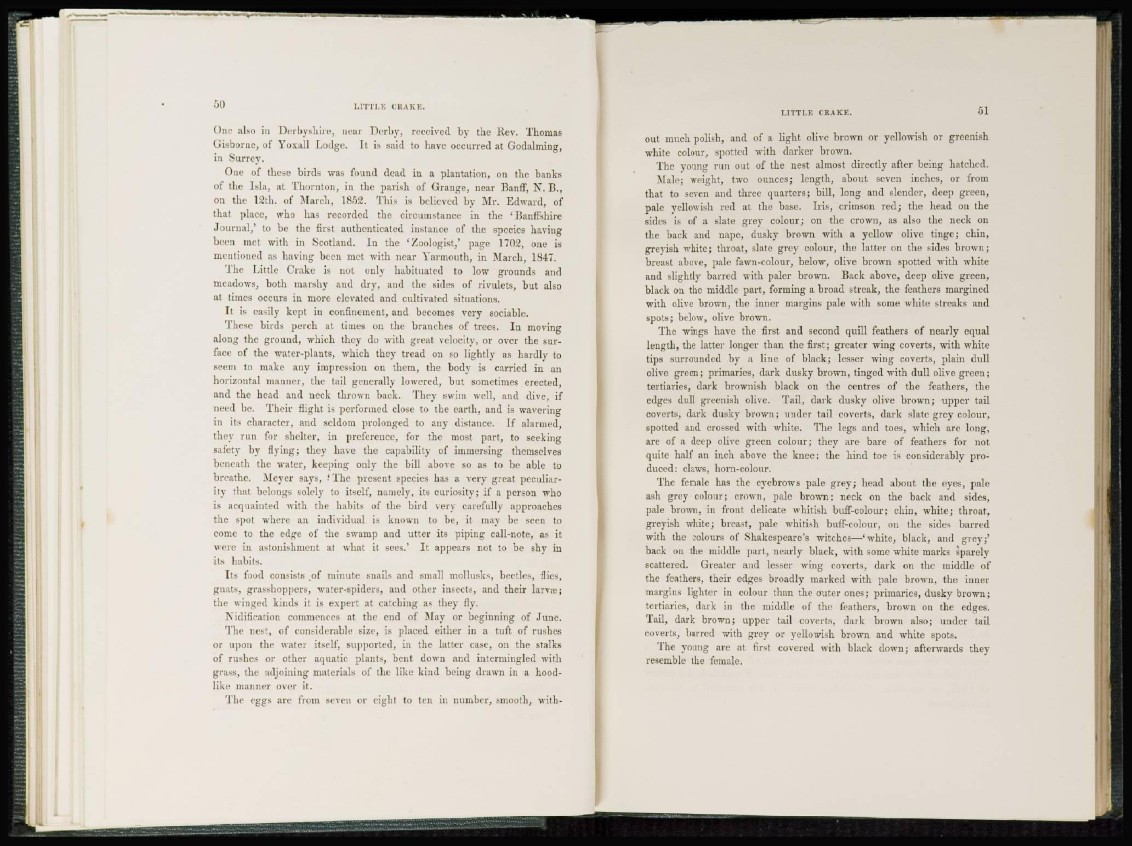
50 LITTLE CRAKE.
One also in Derbyshire, near Derby, received by the lie v. Thomas
Gisborne, of Yoxall Lodge. It is said to have occurred at Godalming,
in Surrey.
One of these birds was found dead in a plantation, on the banks
of the Isla, at Thornton, in the parish of Grange, near Banff, N. B.,
on the 12th. of March, 1852. This is believed by Mr. Edward, of
that place, who has recorded the circumstance in the ' Banffshire
J o u r n a l , ' to be the first authenticated instance of the species having
been met with in Scotland. In the 'Zoologist,* page 1702, one is
mentioned as having been met with near Yarmouth, in March, 1847.
The Little Crake is not only habituated to low grounds and
meadows, both marshy and dry, and the sides of rivulets, but also
at times occurs in more elevated and cultivated situations.
I t is easily kept in confinement, and becomes very sociable.
These birds perch at times on the branches of trees. In moving
along the ground, which they do with great velocity, or over the surface
of the water-plants, which they tread on so lightly as hardly to
seem to make any impression on them, the body is carried in an
horizontal manner, the tail generally lowered, but sometimes erected,
and the head and neck thrown back. They swim well, and dive, if
need be. Their flight is performed close to the earth, and is wavering
in its character, and seldom prolonged to any distance. If alarmed,
they run for shelter, in preference, for the most part, to seeking
safety by flying; they have the capability of immersing themselves
beneath the water, keeping only the bill above so as to be able to
breathe. Meyer says, ' T h e present species has a very great peculiarity
that belongs solely to itself, namely, its curiosity; if a person who
is acquainted with the habits of the bird very carefully approaches
the spot where an individual is known to be, it may be seen to
come to the edge of the swamp and utter its piping call-note, as it
were in astonishment at what it sees.' It appears not to be shy in
its habits.
Its food consists of minute snails and small mollushs, beetles, flies,
gnats, grasshoppers, water-spiders, and other insects, and their larva?;
the winged kinds it is expert at catching as they fly.
Nidification commences at the end of May or beginning of June.
The l i e s ' , of considerable size, is placed either in a tuft of rushes
or upon the water itself, supported, in the latter case, on the stalks
of rushes or other aquatic plants, bent down and intermingled with
grass, the adjoining materials of the like kind being drawn in a hoodlike
manner over it.
The eggs are from seven or eight to ten in number, smooth, with-
L I T T L E CRAKE. 51
out much polish, and of a light olive brown or yellowish or greenish
white colour, spotted with darker brown.
The young run out of the nest almost directly after being hatched.
Male; weight, two ounces; length, about seven inches, or from
that to seven and three quarters; bill, long and slender, deep green,
pale yellowish red at the base. Iris, crimson red; the head on the
sides is of a slate grey colour; on the crown, as also the neck on
the back and nape, dusky brown with a yellow olive tinge; chin,
greyish white; throat, slate grey colour, the latter on the sides brown;
breast above, pale fawn-colour, below, olive brown spotted with white
and slightly barred with paler brown. Back above, deep olive green,
black on the middle part, forming a broad streak, the feathers margined
with olive brown, the inner margins pale with some white streaks and
spots; below, olive brown.
The wings have the first and second quill feathers of nearly equal
length, the latter longer than the first; greater wing coverts, with white
tips surrounded by a line of black; lesser wing coverts, plain dull
olive green; primaries, dark dusky brown, tinged with dull olive green;
tertiaries, dark brownish black on the centres of the feathers, the
edges dull greenish olive. Tail, dark dusky olive brown; upper tail
coverts, dark dusky brown; under tail coverts, dark slate grey colour,
spotted and crossed with white. The legs and toes, which are long,
are of a deep olive green colour; they are bare of feathers for not
quite half an inch above the knee; the hind toe is considerably produced:
claws, horn-colour.
The female has the eyebrows pale grey; head about the eyes, pale
ash grey colour; crown, pale brown; neck on the back and sides,
pale brown, in front delicate whitish buff-colour; chin, white; throat,
greyish white; breast, pale whitish buff-colour, on the sides barred
with the colours of Shakespeare's witches—'white, black, and grey;5
back on the middle part, nearly black, with some white marks sparely
scattered. Greater and lesser wing coverts, dark on the middle of
the feathers, their edges broadly marked with pale brown, the inner
margins lighter in colour than the outer ones; primaries, dusky brown;
tertiaries, dark in the middle of the feathers, brown on the edges.
Tail, dark brown; upper tail coverts, dark brown also; under tail
coverts, barred with grey or yellowish brown and white spots.
The young are at first covered with black down; afterwards they
resemble the female.